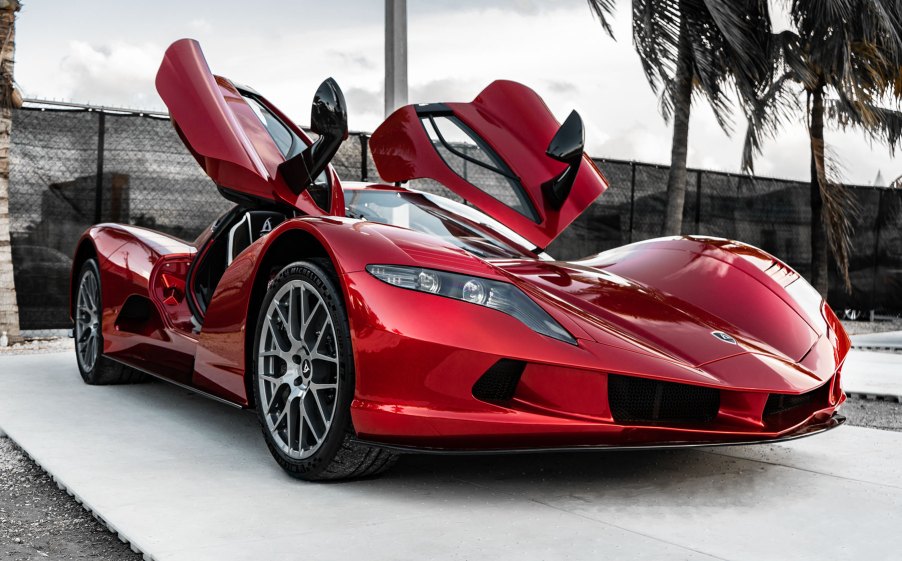
The Aspark Owl Is an ‘Insane-Looking’ EV Supercar Says U.S. News
In the burgeoning segment of EV hypercars, new and exciting vehicle shapes are now piloted on roads and race tracks that are real head-turners. Since there’s no engine taking up space in the front or behind the driver, an evolution of figures evokes life-like qualities out of machinery made of carbon fiber.
With every inch of its striking curves and sharp, aggressive lines screaming “exotic,” the Aspark Owl enters the market as Japan’s first fully-electric hypercar.
Who makes the Aspark Owl?
Referred to as “insane-looking” by U.S. News and World Report, the dramatically-styled EV hypercar owes its creation to Aspark. The company was founded in 2005 by Japanese businessman Masanori Yoshida. The Osaka, Japan-based engineering firm has well over 3,000 employees at 25 offices around the world. It is known as one of Asia’s leading engineering firms in the chemical, medical, technical, and now automotive sectors.
Yet, the Aspark Owl isn’t built in Japan or even in Asia. The Owl is produced at the company’s production center in Turin, Italy, in the facility of its local collaborator, Italian coachbuilding firm Manifattura Automobili Torino.
Most may not know M.A.T., but some may have seen their limited-run, one-off, high-horsepower productions like:
- Apollo Intensa Emozione
- Devel Sixteen
- Scuderia Cameron Glickenhaus SCG 003
- New (Lancia) Stratos
How fast is the Aspark Owl?
Along with extraordinary looks, the Aspark Owl provides extraordinary performance figures. The manufacturer themselves describes the Owl as the fastest-accelerating car in the world. The Owl has a claimed 0-60 mph time of 1.69 seconds with a one-foot rollout. According to the Aspark’s manufacturer’s brochure, the 0-100 kph time, which includes a standing start, is an impressive 1.9 seconds.
The Aspark Owl achieves this feat with a 64 kWh battery pack and four electric motors. With one on each wheel, the Owl puts out 1,984 hp and 1,475 lb-ft of torque. According to EV Auto Explorer, Aspark’s electric motors have the fastest rotation speed ever at 15,000 revolutions per minute.
With a dry weight of 1,900 kg, roughly as much as a 2022 Dodge Charger, the Owl is a heavy bird. Regardless, with a unique torque vectoring system, it’ll be no slouch around the track and can reach a theoretical top speed of almost 249 mph while getting 280 miles to a charge.
Insane-looking design

The Owl is reminiscent of a Le Mans racer with its ultra-flat, low-to-the-ground design. It sports a height of just 99 centimeters, or right under 39 inches, which Aspark says is “probably the lowest road legal electric hypercar in the world.”
Every part of the Owl’s carbon fiber exterior is functional to help it achieve its performance figures. The single-piece carbon fiber monocoque chassis is the foundation of the Owl’s honeycomb structure, where the battery is mounted along the car’s spine for better weight distribution and a lower center of gravity. The unique pitches and rakes in the body make the car look alive, and when the rear wing raises to provide better downforce, it does beg a comparison to a predatory bird swooping down on its prey.
For drivers, the experience won’t be like anything for a road car. Like a Formula One car, the driver will be nearly lying down in the cockpit in front of the button-laden, flat-bottomed steering wheel, flanked by four screens on a leather-trimmed dash evoking what Aspark calls “a modern concept of luxury.”
How much is an Aspark Owl?
Aspark will offer the Owl in a single trim package with a bespoke after-sales service with various accoutrements. The car in a completely “stock” form will set you back more than $3.5 million.
Is the Aspark Owl for sale?
Although the Owl’s production suffered nearly four years of delays, the building began back in January 2021. Currently, only 50 cars are slated for production.
Aspark says 20 Owls are destined for Asia and the Middle East, 20 for Europe, and just 10 for North America. However, your likelihood of buying one is even less than seeing one. Unfortunately, all 50 are sold out, so you may have to look far and wide for the one fortunate dealership happy to let you look at the hypercar in their showroom.


